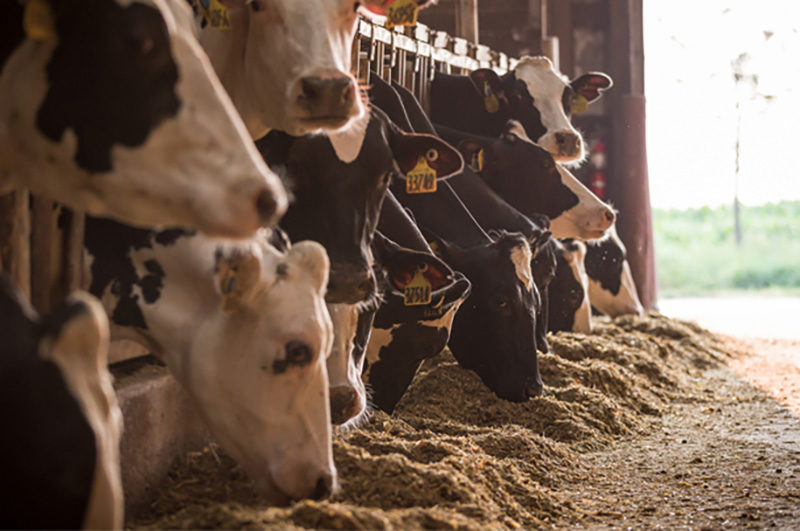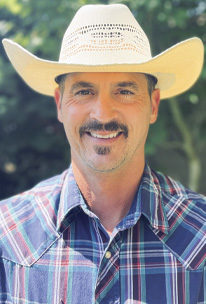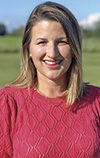Crystal Prom: Dairy nutrition consultant in southern Wisconsin
What question are producers asking you right now?
Do we have enough forage inventory to get us through the year?
This past summer has brought drought conditions to many pockets in the Midwest and throughout the Corn Belt. This leaves many dairy producers concerned about their own forage inventories and buying feed through next year’s harvest.
How do you come up with a solution?
Once harvest is done, I’ll measure the forage piles using either a measuring wheel or a drone. Based on dry matter and density, I can then predict how much feed is in the pile. The next step is to calculate how much feed is needed at the planned feeding rates until the next harvest. In the case of drought-stressed corn, I would also use lab tests to account for the altered nutrient profile. If this information tells us forage inventory is tight, then comes the discussion of finding additional feed options, limiting unnecessary animal numbers and so forth.
Finding corn silage to buy after the harvest season is challenging and expensive. The more likely scenario is to supplement with a combination of corn, corn byproducts and commodities that supply fiber such as cottonseed or soyhulls.
What are some tools and resources to use?
I will monitor feed inventory on a farm all year-round by periodically measuring feed piles. This way producers can project how many days’ worth of each forage is left based on the pace it is fed out. If available, I also use data from the farm’s feed software program to project inventories from daily feeding rates. If we think we might be tight on forage or are looking to make changes, I can use my ration balancing software program to calculate “what-if” scenarios and strategize profitability for both the short term and entire year.
What does implementation look like?
Implementation involves understanding inventory projections and planned diet changes to help conserve corn silage. This strategy may shift as weather, markets and herd dynamics change and should be re-discussed regularly throughout the year.
Jackson Parriera: Dairy nutrition consultant in Washington and Oregon
What question are producers asking you right now?
The biggest question I am receiving is, “How do we survive the next X number of months with an inverted commodity/milk market?”
How do you come up with a solution?
Here I would focus on four different strategies that can lower costs and/or improve management practices.
- Capitalize on high beef prices by culling animals that are not profitable (do-not-breeds, low producers, low-genomic cows and high-SCC cows). This creates room for the high-performing animals and gives you the opportunity to add profitable animals.
- Maximize on-farm forages to reduce alfalfa and/or grain purchases. The goal is to save more money per month than potential milk loss.
- Reduce heifer inventories and only raise the number needed for the next X months. Because of the inflated cost of feed and in some cases limited forage inventories, only raise the heifers needed to replace cows in the herd based on culling rates.
- Do all the “little things” right by focusing on cow comfort, bunk management, forage management and so on. All of those little things play into each animal maximizing their potential.
What are some tools and resources to use?
Other consultants and producers are great resources. I speak with many of my teammates to bounce around ideas and learn what’s happening in their region. Technology is also increasingly valuable for producers. I use nutrition software to help me find the best-cost solutions and other ingredients that will maximize efficiency and production.
What does implementation look like?
I have an open and honest dialogue with producers about what their biggest challenges and bottlenecks are. Within the past few months when the market started to invert, we focused quickly on the "low-hanging fruit" and then built plans to address the more complex issues.
Here’s an example: One farm’s TMR was 65% dry matter. After discussing how to get it closer to 50% (to reduce sorting), we decided to buy a water tank to add water to the TMR. This is a relatively inexpensive addition, but it has made a difference in intakes, especially during the summer heat.
Alyssa Dietrich: Dairy calf and heifer specialist in the East and Southeast
What question are producers asking you right now?
How can we get a higher average daily gain (ADG) in our calves?
I get asked this question by almost all the farms I work with. It’s a simple question but requires a unique solution for each operation.
How do you come up with a solution?
The simplest place to start is with milk – are you feeding enough to achieve your ADG goals? The Dairy Calf and Heifer Association (DCHA) says the target growth rate for calves from 24 hours old to weaning (56 days old) is at least to:
- Double birth rate
- Gain 4 to 5 inches in height
The only way to know is to consistently weigh and measure our calves. If possible, I recommend measuring every calf and not using an average birth rate as your starting point – here a scale is more exact than a weigh tape. Also realize that the age of the calf when you gather the second weight affects the ADG result. For example, weighing your calves at 70 days but comparing the ADG to a standard in which calves are weighed at 56 days – you’re not comparing apples to apples.
What are some tools and resources to use?
My greatest tool is asking questions and being on-farm to see protocols in action. While proper nutrition can help growth, how we deliver it and handle our calves is just as important.
A physical tool I highly value are growth prediction models. Like the production models for cows, we now have specific software for recording calf inputs to predict growth and cost. This is helpful if a producer is considering changing their feeding program. The growth prediction models give us an idea of how much more growth to expect by changing certain variables in the feeding program.
What does implementation look like?
Let’s revisit the answer you have for – How much milk are you feeding? And compare it to – What are calves getting fed?
To answer – How much? – I ask the farm about their milk feeding schedule. A feeding schedule states the amount of milk each calf should receive each feeding depending on age. Normally, as calves get older their milk allowance goes up until the weaning process starts. What a calf is getting fed needs to be seen in real time during feeding and regularly monitored.
Here’s an example: Last spring, a farm was confused why they weren't reaching the expected growth rates from their feeding schedule. I came to the farm, watched their calf team mix and deliver milk, and found the tank system for automatically measuring the correct amount of milk was broken. Ultimately, they were just guessing, and each calf was getting an inconsistent amount of milk, not the amount decided by the feeding schedule.
Kirstin Joyal: Dairy nutrition consultant in Vermont and northeastern New York
What question are producers asking you right now?
The most frequent questions I receive are commonly rooted in the individual farm’s viability. Recently, the focus has been, “How can we be more practical and capitalize on tight margins with the current markets?"
How do you come up with a solution?
In any market, I always evaluate nutrition to make sure the most cost-effective ration is in place, relative to both the milk and commodity markets. Feed is a farm’s greatest expense; beyond ration balancing it’s important to evaluate feed management for efficiency.
We like to start by communicating with the feeder and/or feed team. They will tell you where their bottlenecks are if you engage them in a collaborative way. Next, see whether standard operating procedures are being followed and are efficient. You may find they are but also see that an added feed push-up is necessary or that a pen needs a larger percentage of their ration delivered in their first feeding versus their next. Additionally, give yourself the time to look over data, lab reports and consultant notes. Dairies collect a lot of data, often more than you have the time to sift through. I recommend developing a “feed manager report” to collect and organize the data and numbers you find most valuable and evaluate it weekly.
What are some tools and resources to use?
The tools I use are farm-specific. We have various tools that my team has developed to use farm feed data. I also use camera data, TMR audits and parametric auditing through a ration balancing program to help find how much an ingredient can cost, including handling, before it prices out of the ration.
What does implementation look like?
Implementation requires full team effort. Before manipulating any feeding program, start with dialing in your accuracy as tight as possible. This process includes analyzing load reports, ensuring you have the right equipment, settings, achievable ingredient feeding rates, training and more. The next steps are situation-dependent – reorganizing ingredient locations, staging forages, to running partial budgets on a feeding center.
Whenever you’ve got to make a tough nutrition decision, we can just ask MAX. We’ve updated our powerful nutrition software solution to give your Cargill Consultant the clarity needed to help make complex decisions. More detailed data. Better insights. Real-time feedback. Everything your consultant needs to add more precision and profitability to your nutrition – and make tough decisions easier.
Interested in seeing MAX in action? Get in touch with a Cargill Consultant today.










